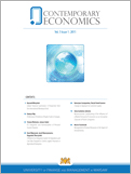Middle-Income Trap - Threat or Reality
Middle-Income Trap - Threat or Reality
Author(s): Bozena LevenSubject(s): National Economy, Financial Markets
Published by: VIZJA University
Keywords: Economic growth and aggregate productivity; international factor movements; middle income trap;
Summary/Abstract: The middle-income trap (MIT) describes obstacles to sustainable growth experienced by some middle-income countries. The initial growth of emerging economies is often characterized by reliance on labor intense, import driven factors, facilitated by foreign direct investment (FDI). As it matures, that initial growth becomes more dependent on foreign technology imports to produce exports, which can impede sustained growth. Poland is representative of several middle-income East European countries; after the 1990 transition, Poland had inadequate infrastructure and obsolescent industries, but a work force that was highly educated. Since 1990, relatively low labor costs, technology imports, European Union (EU) funding, and FDI have propelled Poland to middle-income status. However, Poland’s comparative labor advantages have recently diminished, while both the quantity and composition of FDI inflows are changing. In this paper, we examine whether some growth factors have been exhausted, leaving Poland subject to MIT. To answer this question, we assess changes in investment and factor productivity, labor force educational attainments, FDI, new product/technology development, imports, export diversification, product complexity, and other factors. We conclude that in Poland several conditions consistent with MIT are gaining importance and may be an early warning sign of challenges to its future growth.
Journal: Contemporary Economics
- Issue Year: 15/2021
- Issue No: 3
- Page Range: 321-331
- Page Count: 11
- Language: English

